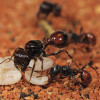The evolution of songbirds and vocal learning
Interview with
How did birds evolve to sing in the first place? Erich Jarvis from Rockefeller University is an expert in the evolution of birdsong, and he spoke to Chris Smith...
Erich - All birds and even humans and non-human primates and frogs and so forth, all of them have the auditory pathway that Mimi was talking about to perceive sound. Like your dog can understand the word sit. But only the species like us humans and these songbirds have these other brain pathways she was talking about for producing the sounds. And, just like you asked ,that brain pathway, even though it's only in a few groups of animals like us humans and songbirds, it evolved in a very similar way, consisting of a motor pathway to produce the sounds and this forebrain loop that she talked about to actually imitate the sounds you produce.
Chris - Could, therefore, birds that aren't naturally songbirds, be actually taught to sing, then?
Erich - Not, unless they have this forebrain pathway that controls the production to imitate the sounds. You would have, it would have to evolve it or experimentally you would have to induce it.
Chris - So a seagull, for instance, couldn't sing like a zebra finch.
Erich - Right exactly. So a seagull can understand and listen to a zebra finch song or other seagull vocalisations and maybe understand the meaning, but the seagull cannot actually imitate another bird song, unlike the zebra finch, which can.
Chris - Now given that birds evolved from dinosaurs, does that mean then that dinosaurs were vocal in the same sort of way? Were they probably singing like songbirds, some of them?
Erich - Yeah, so the vocal learning birds evolved between 30 and 50 million years ago, but birds go back well beyond a 100, 200 something million years ago. But bird brains and birds themselves are actually dinosaurs. And there's more and more evidence to show that the brain regions that support the vocal learning circuits in birds, and that is the subdivisions in which they are housed, those subdivisions you can find in all birds and in crocodiles and in lizards and in turtles. So I think dinosaurs had the capacity to evolve vocal learning. Whether that happened or not we don't know, but still they did have the capacity in terms of the brain subdivisions.
Chris - Well, they were certainly very musical weren't they, I mean, think about T-Rex. Sorry. Bad joke! But why I wanted to bring up T-Rex was this whole question also, because it's not just about sound, is it, it's all about rhythm as much as anything else. So is there anything special about birds brains that mean they're very good at timing so they can count beats, get the rhythm right?
Erich - Yeah. Good question. So it was shown about 10 years ago actually that only vocal learning species can learn how to dance. And what I mean by that is learn to move their body muscles to a rhythmic beat of music - like one, two, three, four, one, two, three, four to the downbeat for example, on the one. Other animals will respond to human music, but they won't be able to synchronise their body rhythms to the music. And what's going on here, I hypothesise, that once the vocal learning pathway evolved to take sounds that you hear and imitate it through larynx, your vocal organ, what happened is that the hearing information contaminated the rest of the brain and not only is it influencing your vocal organs to produce the sounds, it it influencing your hands, your chest, your legs in a rhythmic fashion that you don't see in the other species that can't imitate.










Comments
Add a comment